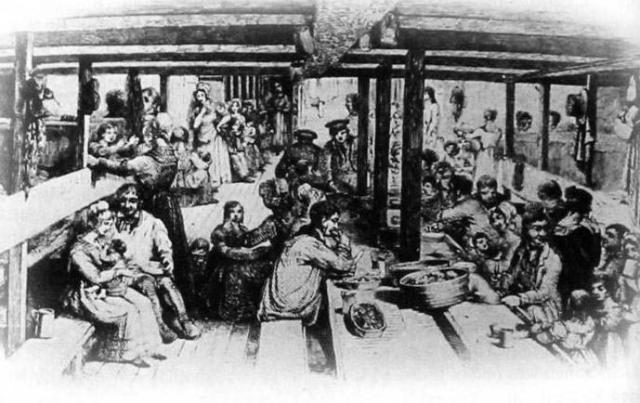Mary Ann Aldis (1794-1889)
This picture shows the dining room or mess of an emigrant ship in the 1840s, it was also where the emigrants slept: note the rows of bunks along the sides of the trestle tables. On many ships orderlies were elected from the passengers and it was their duty to collect provisions for the day from the Quartermaster and distribute them fairly amongst everyone – the general provisions such as flour, rice etc having been pooled as people boarded the ships. How comfortable and well managed the journey was very much down to the expertise of the manager and over-seer of the passengers. Some fared far better than others – and it is to hoped that Mary Ann and her family had a good manager.
The Journal of Anna Brownell Jameson, an intrepid early traveller, contains many vivid descriptions of her journey through Canada – a Canada that Mary Ann must have experienced. In January 1837 she was travelling between two towns near to Niagara by sleigh.
‘It was now dark, and, the snow falling thick, and soon it became impossible to distinguish the sleigh track. Mr Campbell loosened the reigns and left the horses to their own instinct – assuring me it was the safest way of proceeding. After this I remember no more distinctly but awoke as from a nightmare to find myself in the bottom of the sleigh and half smothered and Mr Campbell no where to be seen. ….We had fallen down a the bed of a rivulet, or mill-race as I believe they are called. It was impossible for the gentleman to leave the horses which were plunging furiously up to their shoulders in snow, so I set off to find assistance………..After scrambling through many a snow-drift I reached a forge where a man was hammering……as I advanced into the red light of the fire the man’s eyes fell upon me, and I shall never forget his look as he stood hammer poised in bewildered amazement. I could not get an answer from him, he opened his mouth but just repeated, ‘Aw’ without moving. I turned away in despair and after some more scrambling up and down I found my self in a village and was directed to an inn.
Assistance was immediately sent off to Mr Campbell and in a few minutes the supper table was spread and a pile of logs higher than myself blazing in the chimney: venison steaks, and fried fish, coffee and hot cakes, cheese and whiskey punch ( the traveller’s fare in Canada) were soon smoking on the table; our landlady presided and the evening passed merrily away……………….Forty years before her husband had emigrated , and built a hovel and made a little clearing on the edge of the lake. At that time there was no other habitation and they passed several years in almost absolute solitude. They now have three farms, some hundred acres of land and have brought up nine sons and daughters, most of whom are married and settled on lands of their own………….I can give you no idea of the intense cold of this night…………………..’
Some of Anna Browell Jameson’s views on the way of life in Canada and they perhaps show just how difficult things must have been for Mary Ann – a woman on her own –with only teen-aged sons to protect her.
January 1837. The country, they say, is most beautiful in summer, taxes are trifling, scarcely felt, and there are no poor rates, yet ignorance, recklessness and despondency and inebriety, seem to prevail. A, who has been settled here for five years, and B, himself a Canadian, rate the morality of the Canadian population frightfully low; lying and drunkenness they spoke of as almost universal; men who come here with sober habits quickly fall into the vice of the country; and those who have the least propensity to drinking find the means of gratification comparatively cheaply, and little check from public opinion.
I asked for a bookseller’s shop; there is not one in the town, but plenty of taverns. There is a duty of thirty per cent on books imported from the United States, and the duty on books imported from England adds at least one third to their price; but there is no duty on whisky.
Sending letters was very expensive – but so was receiving them – some emigrants could not afford it. Perhaps Mary Ann wrote to her brother, perhaps he wrote to her. To date no letters have been found. Communication was difficult. In Chatham in the summer of 1837 Anna wrote,
‘The poor emigrants who have not been long from the old country, round whose tender hearts remembrances of parents and home yet cling… sometimes present themselves at the post-office and on finding that their letters cost three shillings and four pence or sometimes five or six shillings , turn away in despair. At Brantford I saw forty-eight such letters….’
Yet, however determined and stoical, the death of her only surviving daughter could not have entered her calculations or come within the scope of anticipated misfortune. There is no evidence to support the supposition that daughter Mary Ann, who would have been about twelve years old, died during the voyage; on the other hand, the complete absence of reference to young Mary Ann, in either England or Canada, points to this conclusion.
There is no death or burial record, no record of her marrying in Canada. Did she remain behind in England in the care of her uncle Alfred or one of her other aunts or uncles? No trace of her has been found in the 1841 Census when she would have been about 16 years old and still unmarried. So the most likely explanation would seem to be that she perished during the voyage; and her mother would have had to confront a tragedy, as she would see it, of her own making.


